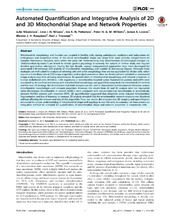| dc.contributor.author | Nikolaisen, Julie | en_US |
| dc.contributor.author | Nilsson, Linn Iren Hodneland | en_US |
| dc.contributor.author | Pettersen, Ina Katrine Nitschke | en_US |
| dc.contributor.author | Willems, Peter H. G. M. | en_US |
| dc.contributor.author | Lorens, James B. | en_US |
| dc.contributor.author | Koopman, Werner J. H. | en_US |
| dc.contributor.author | Tronstad, Karl Johan | en_US |
| dc.date.accessioned | 2014-12-22T11:22:02Z | |
| dc.date.available | 2014-12-22T11:22:02Z | |
| dc.date.issued | 2014-07-02 | eng |
| dc.identifier.issn | 1932-6203 | |
| dc.identifier.uri | https://hdl.handle.net/1956/9013 | |
| dc.description.abstract | Mitochondrial morphology and function are coupled in healthy cells, during pathological conditions and (adaptation to) endogenous and exogenous stress. In this sense mitochondrial shape can range from small globular compartments to complex filamentous networks, even within the same cell. Understanding how mitochondrial morphological changes (i.e. “mitochondrial dynamics”) are linked to cellular (patho) physiology is currently the subject of intense study and requires detailed quantitative information. During the last decade, various computational approaches have been developed for automated 2-dimensional (2D) analysis of mitochondrial morphology and number in microscopy images. Although these strategies are well suited for analysis of adhering cells with a flat morphology they are not applicable for thicker cells, which require a three-dimensional (3D) image acquisition and analysis procedure. Here we developed and validated an automated image analysis algorithm allowing simultaneous 3D quantification of mitochondrial morphology and network properties in human endothelial cells (HUVECs). Cells expressing a mitochondria-targeted green fluorescence protein (mitoGFP) were visualized by 3D confocal microscopy and mitochondrial morphology was quantified using both the established 2D method and the new 3D strategy. We demonstrate that both analyses can be used to characterize and discriminate between various mitochondrial morphologies and network properties. However, the results from 2D and 3D analysis were not equivalent when filamentous mitochondria in normal HUVECs were compared with circular/spherical mitochondria in metabolically stressed HUVECs treated with rotenone (ROT). 2D quantification suggested that metabolic stress induced mitochondrial fragmentation and loss of biomass. In contrast, 3D analysis revealed that the mitochondrial network structure was dissolved without affecting the amount and size of the organelles. Thus, our results demonstrate that 3D imaging and quantification are crucial for proper understanding of mitochondrial shape and topology in non-flat cells. In summary, we here present an integrative method for unbiased 3D quantification of mitochondrial shape and network properties in mammalian cells. | en_US |
| dc.language.iso | eng | eng |
| dc.publisher | PLoS | eng |
| dc.rights | Attribution CC BY | eng |
| dc.rights.uri | http://creativecommons.org/licenses/by/4.0/ | eng |
| dc.title | Automated Quantification and Integrative Analysis of 2D and 3D Mitochondrial Shape and Network Properties | en_US |
| dc.type | Peer reviewed | |
| dc.type | Journal article | |
| dc.description.version | publishedVersion | en_US |
| dc.rights.holder | Copyright 2014 Nikolaisen et al | |
| dc.source.articlenumber | e101365 | |
| dc.identifier.doi | https://doi.org/10.1371/journal.pone.0101365 | |
| dc.identifier.cristin | 1150554 | |
| dc.source.journal | PLoS ONE | |
| dc.source.40 | 9 | |
| dc.source.14 | 7 | |

